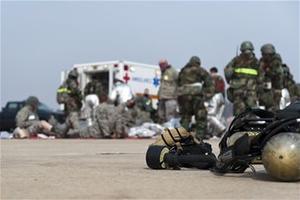First responseU.S. military trains to support civil authorities during domestic CBRN incident
Vibrant Response 13-2 exercise, conducted by U.S. Northern Command and led by U.S. Army North (Fifth Army), is an annual event and is the country’s largest CBRN exercise. The training exercise is used to evaluate a military unit’s operational and tactical ability to support civil authorities during domestic incidents involving chemical, biological, radiological, or nuclear weapons.

Members of the WolfPack exercise prepare for maneuvers // Source: pacaf.af.mil
Members of the 52nd Weapons of Mass Destruction-Civil Support Team from Columbus, Ohio, and the 103rd Weapons of Mass Destruction-Civil Support Team from Fort Richardson, Alaska, responded to a simulated chemical, biological, radiological, nuclear incident 30-31 July at the Vibrant Response 13-2 exercise at Muscatatuck Urban Training Center in Butlerville, Indiana. Army News Service reports that VR13-2, conducted by U.S. Northern Command and led by U.S. Army North (Fifth Army), is an annual event and is the country’s largest CBRN exercise; the training exercise is used to evaluate a unit’s operational and tactical ability to support civil authorities during domestic incidents.
The Ohio and Alaska Civil Support Teams are two of fifty-seven specialized Army and Air National Guard teams around the nation. The units provide support to civil authorities in the event of a CBRN incident by deploying rapidly to assist local first responders in determining the precise nature of an incident as well as providing expert medical and technical advice to the local commander.
“We respond to domestic incidences such as chemical, biological, radiological and nuclear because we have the personnel, equipment and expertise to conduct radiological surveys. These surveys are done to determine where some radiological hotspots are, or are not, in order for civilian first responders to drop food, water and medical supplies to those who need it,” said Lt. Col Jeffrey Suver, commander of the 52nd WMD-CST.
The CST team plays an important role in providing valuable feedback to the incident commander and the civilian first responders, who will be taking care of the community surrounding the incident site.
“We are the first responders,” said Sgt. Dustin Laycock, member of the 52nd WMD-CST. “We tell the incident commander or whoever is in charge what chemical agents and at what levels are present at the incident site, chemical protective measures that will need to be enforced, identify standoff distances and minimum safe areas, and identify those hazards and the necessary steps to mitigate those hazards.”
The chemical suits used by the CST teams are vital in that they provide the needed protection for the team members to perform their missions.
“The suits are used to identify unknowns or when we suspect a high-vapor concentration of organic compounds. Although the suits serve as the best layer of protection that we have, the penetration times vary with the different chemicals,” said Laycock. “They pretty much serve as a little protective bubble that we are fully encapsulated. They allow us to be able to use the self-contained breathing apparatus located on the inside of the suit in the event of a chemical breakthrough.”
The equipment, along with the continuous training — such as participating in joint training environments — makes the CST teams and their members experts at conducting CBRN operations.
“I like to get out and participate in national level exercises like these,” said Suver, “because they provide an opportunity for us to work with various agencies on the national level that are outside of the state of Ohio in order to get a big picture approach in the event that we have to respond to a national level incident.”
